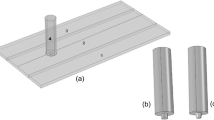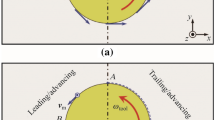Abstract
This paper considers the theoretical aspects required for the development of a coupled two-dimensional axi-symmetrical computational fluid dynamics (CFD) and heat transfer model for the friction taper hydro-pillar process (FTHPP). The model applies the plasticised material movement during welding as the laminar, viscous flow of a non-Newtonian fluid, while making use of a dynamic mesh to simulate the continuous deformation of plasticised material at the friction interface. The plastic material flows through a stationary discretized flow domain not requiring a moving mesh, resulting in the Eulerian CFD approach being effective - this CFD material flow model thus avoids the requirement for re-meshing. The material properties are entered via a viscosity function used to describe the flow stress, locally dependent on material strain rate and temperature. A non-linear multiphysics problem exists as the frictional and viscous heating act as heat sources. The simulation model applies an iterative approach for coupling the plastic deformation flow analysis with the thermal analysis. Strain rate and temperature distribution of the welding material mutually affect each other, as the flow stress is temperature-dependent and the plastic work (adiabatic shear) performed during the process generates heat, in addition to heat added by friction. Isotropic temperature-dependent thermo-physical properties are required and thus incorporated into the model. A successfully coupled simulation is presented with the thermal response analysis delivering the temperature distribution through the weld for which process temperature and subsequent hardness plots are drafted. Measurements obtained from experimental welds show favourable comparison, validating computed values. The presented work attempt to show how comprehensive numerical modelling, carried out through computer simulation, can assist in the analysis of the identified process characteristics during FTHPP.























Similar content being viewed by others
References
Thomas W, Nicholas D. Leading Edge: Friction Hydro Pillar Processing. TWI Connect
Hattingh D, Wielligh L, Thomas W (2015) Friction processing as an alternative joining technology for th enuclear industry. J S Afr Inst Mint Metall 115. https://doi.org/10.17159/2411-9717
Thomas W, Nicholas D. The need for gas shielding - positive advantages for two friction processes. TWI Bulletin
Hattingh D, Steuwer A, James M, Wedderburn I (2010) Residual stresses in overlapping friction taper stud welds. In: Proceedings of MECA-SENS 5, 5th International Conference on Mechanical Stress Evaluation by Neutrons and Synchrotron Radiation, Material Science Forum. vol. 652. Mito, Japan
Hattingh D, Bulbring D, Els-Botes A, James M (2011) Process parameters influence on performance of friction taper stud welds in AISI 4140. Mater Des. https://doi.org/10.1016/j.matdes.2011.02.001
Pinheiro G. Friction Hydro Pillar Processing of lightweight alloys: Bonding mechanisms and Joint properties. Institute of Materials Research, GKSS-Forschungszentrum, Germany
Welding Handbook (2015) vol. 3. 9th ed. American Welding Society
van Zyl C, Hattingh D (2019) Statistical Analysis of effects on weld response variables during Friction Hydro-Pillar Processing. R &D Journal of the South African Institution of Mechanical Engineering. https://doi.org/10.17159/2309-8988/2019/v35a2
Vicharapu B, Kanan L, Clarke T, De A (2017) An investigation on friction hydro-pillar processing. Sci Technol Weld Join 22(7). https://doi.org/10.1080/13621718.2016.1274849
Li G, Kobayashi S (1982) Rigid-Plastic Finite-Element analysis of plane strain rolling. J Eng Ind 104(1)
Lindgren LE (2006) Numerical modelling of Welding. Computer Methods in Applied Mechanics and Engineering p. 195. https://doi.org/10.1016/j.cma.2005.08.018
Goldak J, Bibby M, Moore R, Patel B (1986) Computer modelling of heat flow in welds. Metall Trans B p. 17
Sluzalec A (1990) Thermal effects of Friction Welding. Int J Mech Sci 32(6):467–478. https://doi.org/10.1016/0020-7403(90)90153-A
Balasubramanian V, Li YST, Crompton J, Soboyejo A, Katsube N, Soboyejo W (1999) A new friction law for the modelling of continuous drive friction welding: Applications to 1045 steel welds. Mater Manuf Process 14(6). https://doi.org/10.1080/10426919908914877
Bendszak GB, North TH (1997) Modelling of fluid dynamics and heat transfer in Friction Welding. Trans Japan Welding Research 25(2):171–184
Bendszak GB, North TH, Li Z (1997) Numerical model for steady flow in friction welding. Acta Metall Mater 45(4):1735–1745
Bhattacharya S, Majumber A, Basu S (1982) Mathematical modeling of metal extrusion process. J Eng Ind 104(1)
Zhang Z, Dai G, Wu S, Dong L, Liu L (2009) Simulation of 42CrMo steel billet upsetting and its defects during forming process based on the software DEFORM-3D. Mater Sci Eng A p. 499. https://doi.org/10.1016/j.msea.2007.11.135
Lin Y, Chen XM (2010) A combined Johnson-Cook and Zerilli-Armstrong model for hot compresses typical high-strength alloy steel. Comput Mater Sci 49(3). https://doi.org/10.1016/j.commatsci.2010.09.001
Kim S, Lee Y, Byon S (2003) Study on constitutive relation of AISI4140 steel subject to large strain at elevated temperatures. J Mater Process Technol p. 140. https://doi.org/10.1016/S0924-0136(03)00742-8
Fu L (1998) Duan L. The coupled deformation and heat flow analysis by finite element method during friction welding. 77:202–207
Seidel T, Reynolds A (2003) Two-dimensional friction stir welding process model based on fluid mechanics. Sci Technol Weld Join 8(3). https://doi.org/10.1179/136217103225010952
Yilmaz M, Col M, Acet M (2002) Interface properties of aluminum/steel friction welded components. Mater Charact 49(5). https://doi.org/10.1016/S1044-5803(03)00051-2
Frigaard O, Grong O, Midling O (2006) A process model for the friction stir welding of age hardened Aluminium alloys. Metall Mater Trans A 32(5). https://doi.org/10.1007/s11661-001-0128-4
Landell R, Kanan L, Buzzatti D, Vicharapu B (2020) Material flow during hydro-pillar processing. Sci Technol Weld Join 25(3). https://doi.org/10.1080/13621718.2019.1679963
van Zyl C. Process heat flow model for temperature and hardness prediction during Friction Taper Stud Welding of AISI 4140 [PhD Thesis]. South Africa
Mapelli C, Corna C, Magni F (2008) Simulation of plastic deformation processes through a navier-stokes approach. In: Cammarata G, Petrone G, editors. Modelling and Simulation. Milan p. 223–232
Lin Y, Chen M, Zhong J (2008) Constitutive modeling for elevated temperature flow behavior of 42CrMo steel. Comput Mater Sci p. 42. https://doi.org/10.1016/j.commatsci.2007.08.011
Schmidt H, Hattel J (2004) Heat source models in simulation of heat flow in Friction Stir Welding. Int J Offshore Polar Eng 14(4). 14th International Offshore and Polar Engineering Conference
Berman A, Drummond C, Israelachvili J (2006) Amontons’ law at the molecular level. Tribol Lett 4(2). https://doi.org/10.1023/A:1019103205079
Blau P (2001) The significance and use of the friction coefficient. Tribol Int 34(9):585–591. https://doi.org/10.1016/S0301-679X(01)00050-0
Chin R, Steif P (1995) A computational study of strain inhomogeneity in wire drawing. Int J Mach Tools Manuf 35(8). https://doi.org/10.1016/0890-6955(95)90403-9
Peterson M, Calabrese S, Lis S, Jiang X (1994) Friction of alloys at high temperatures. J Mater Sci Technol p. 10
Yagi A, Hyde T, Becker A, Williams J, Sun W (2005) Residual stress simulation in welded sections of P91 pipes. J Mater Process Technol. https://doi.org/10.1016/j.jmatprotec.2005.05.036
Yue P, Zhou C, Feng J, Oliver-Gooch C, Hu H (2006) Phase-Field simulations of interfacial dynamics in viscoelastic fluids using finite elements with adaptive meshing. J Comput Phys p. 219. https://doi.org/10.1016/j.jcp.2006.03.016
Vermolen F, Gharasoo M, Zitha P, Bruining J (2009) Numerical solutions of some diffuse interface problems: the cahn-hilliard equation and the model of thomas and windle. Int J Multiscale Comput Eng 7(6). https://doi.org/10.1615/IntJMultCompEng.v7.i6.40
Funding
The authors declare that no external funds, grants, or other support was received during the preparation of this manuscript.
Author information
Authors and Affiliations
Contributions
All authors contributed to the study conception and design. Material preparation, data collection and analysis were performed by Carlo van Zyl. The first draft of the manuscript was written by Carlo van Zyl and all authors commented on previous versions of the manuscript. All authors read and approved the final manuscript.
Corresponding author
Ethics declarations
Competing Interests
The authors have no relevant financial or non-financial interest to disclose.
Additional information
Publisher's Note
Springer Nature remains neutral with regard to jurisdictional claims in published maps and institutional affiliations.
Rights and permissions
Springer Nature or its licensor (e.g. a society or other partner) holds exclusive rights to this article under a publishing agreement with the author(s) or other rightsholder(s); author self-archiving of the accepted manuscript version of this article is solely governed by the terms of such publishing agreement and applicable law.
About this article
Cite this article
van Zyl, C., Lombard, H. & Hattingh, D. Theoretical aspects and design of a numerical model for friction tapered hydro-pillar processing of AISI4140 steel. Int J Adv Manuf Technol 127, 4291–4306 (2023). https://doi.org/10.1007/s00170-023-11476-0
Received:
Accepted:
Published:
Issue Date:
DOI: https://doi.org/10.1007/s00170-023-11476-0




